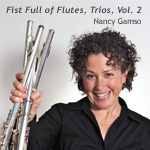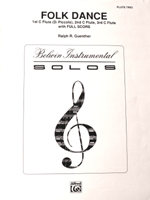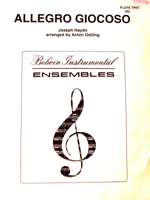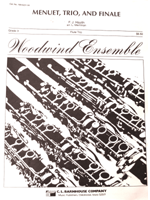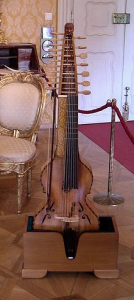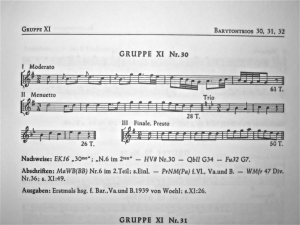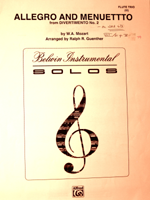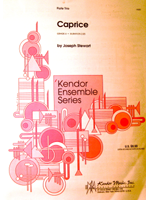Fist Full of Flutes, Trios, Vol. 2
These trios for three C flutes are appropriate for intermediate flutists and also work well for casual classical gigs, sight-reading and adult amateurs. All are published alone and range in style from Classical (Mozart, Haydn) to Neo-Classical (Guenther, Stewart). Complete publishing information can be found below.
Tracks for each piece below are available separately as high-quality mp3 files.
Or, download the entire set (single zip file): Flute-Trios-Vol.-2
Guenther, Ralph R., Folk Dance, Alfred Belwin-Mills Pub. F.D.E. 23-8
Composer Highlights
Professor Ralph R. Guenther, Ph.D. (1914-2007) was the theory, composition and flute teacher at Texas Christian University from 1948 to 1980. He made it through two world wars, and survived the trials of being an Eastman School of Music student during WWII. Since he wrote this work during his teaching years at TCU, we can imagine that he might have written it for his students.
Practice Suggestions
Download Tracks
01-Guenther, Folk Dance, complete version
02-Guenther, Folk Dance, minus 1st part
03-Guenther, Folk Dance, minus 2nd part
04-Guenther, Folk Dance, minus 3rd part
Download all four tracks (single zip file)
Haydn, Joseph; Ostling, Acton, arranger; Allegro Giocoso, Belwin, First Division Pub., F.D. Ens. 2-7
Composer Highlights
Practice Suggestions
Download Tracks
05-Haydn, Allegro Giocoso, complete version
06-Haydn, Allegro Giocoso, minus 1st part
07-Haydn, Allegro Giocoso, minus 2nd part
08-Haydn, Allegro Giocoso, minus 3rd part
Download all four tracks (single zip file)
Haydn, F. J.; Merriman, L., arranger; Menuet, Trio, and Finale, Barnhouse Co., 100-0231-04
Composer Highlights
Franz Joseph Haydn (1732-1809) was the second son of a cartwheel maker and a cook. Are you wondering why the careers of someone’s parents were so important in a historical biography? Well, for someone like Joseph Haydn, who was enormously talented and needed talented and experienced teachers, finding the means to get this young boy an education was incredibly challenging for a father who made cartwheels (actual wooden wheels, not the acrobatic kind) and a mother cooked for the local Count. To complicate this further, they lived far away from anything resembling a music school. Fortunately, Joseph’s dad was a part-time musician and was able to send Joseph to live with a distant cousin who was a music teacher. Even before this music training, it was clear that Joseph was blessed with a great singing voice, destined for the church choir. Soon he made the big time: St. Stephen’s choir school in Vienna, at which he was taught singing, violin, music theory and composition, language and other studies and participated in least 2 performances (masses or other religious services) a day. Haydn had a long career working for one wealthy family, the Esterházy dynasty. His job description not only included composition and performing but also managing the musicians and their uniforms (including properly powdered wigs), the instruments and the library. It is possible that he wrote the very first theatrical symphony, called the ‘Farewell’, in which the performers all ended at different times, blew out their candles (on the music stands) and left the stage, leaving just two violins on stage at the end. It was supposed to be a hint to Prince Nicolas Esterházy that it was time to leave the summer mansion and go home to Vienna.This work is from a trio for baryton, viola and violoncello and written in 1765, one of over 150 works that Haydn composed for this strange looking cello-like instrument, the baryton. Prince Nicholas played the curious object, and since Haydn was hired as the court’s assistant Kapellmeister (he was later promoted to the head honcho) and since the head Kapellmeister, G. J. Werner, was tired of writing baryton chamber music for the Prince, the job fell to young Joseph. The one pictured here is Prince Nicholas’ actual baryton:
Finding the source of this arrangement was the stuff of detective novels. First, I found a German thematic catalog from 1957, Joseph Haydn Thematisch-bibliographisches Werkverzeichnis, compiled by Anthony van Hoboken. Finally on page 609, I ran across a quote of the minuet theme. A library in Maryland sent me a copy of the score and now I have the original baryton/viola/cello version. This minuet/trio and finale are the 2nd and 3rd of this three-movement work.
Practice Suggestions
Minuet/Trio: Two reminders on the minuet/trio form that some arrangers assume you already know, so he/she may not put it in the score: 1) at the return of the minuet, no repeats, 2) the ending is the last measure before the trio. You may notice that in most of the minuet/trios that I recorded, the trio is slightly slower than the minuet. This was the tradition in performance, possibly inherited from the actual dance in which a trio of couples were featured on the trio with more elaborate dance moves, hence the slower tempo. Here I chose a stately quarter = 108 for the minuet and 100 for the trio, for example. I love the minor trio on this one, as it is very beautiful and unusual.Finale: I like to feel the beat at the half note for this movement. I chose 76 to the half note (152 to the quarter) and I chose to omit the repeats on the da capo, as it is often the case in modern performances. This movement has a couple of places where all the instruments are playing in unison. This can boost the dynamic level and can make intonation problems more obvious, so spend some slow ensemble practice on those lines. There are three types of quarter notes here – regular, tenuto and staccato. (Mr. Merriman added the tenuto and staccato, by the way. Herr Haydn would have expected you to have the good taste to perform them without being directed). You should pay attention to how long the group holds the quarter notes. The difference between a regular and a staccato is half the value. The difference between a regular and a tenuto is about more about length and weight; the tenuto indicates a heaviness in the tone and less taper at the end of the note. Think about this as you listen to my recording and your own. I have included a short video demonstrating the Amazing Slow Downer (Part 3) that illustrates in slow audio motion, the differences in length and weight of various flute articulations.
On another subject – do you not just love the A minor section in the second half of the finale? I felt like I was inside of a music box when I was recording this one. Bring out the low notes in the second part, from C through the D section. My favorite part!
Download Tracks
09-Haydn, Menuet & Trio, complete version
11-Haydn, Menuet & Trio, minus 2nd part
10-Haydn, Menuet & Trio, minus 1st part
12-Haydn, Menuet & Trio, minus 3rd part
13-Haydn, Finale, complete version
14-Haydn, Finale, minus 1st part
15-Haydn, Finale, minus 2nd part
16-Haydn, Finale, minus 3rd part
Download all eight tracks (single zip file)
Mozart, W.A.; Guenther, Ralph, arranger; Allegro and Menuetto from Divertimento No. 2; Alfred ENS00176
Composer Highlights
Wolfgang Amadeus Mozart (1756-1891) What can I add to Mozart’s famous story? Well, we can notice that fabulous name –– Johannes Christostomus Wolfgangus Theophilus Mozart (Mozart himself took to the Latin translation of Theophilus: Amadeus, Amadé or Gottlieb for casual occasions). Do you think his parents just couldn’t decide? Let’s remember that Wolfgang was an extremely talented musician, fortunate to receive a wealth of training and experience in music from a very early age. His ability to hear and recall music with the accuracy of a recording device meant that his absorption of all the performances he heard on his tours of Europe and Great Britain was so complete, that his style not only came to embody the best of what we now call the ‘Common Practice Period’ but went beyond in innovative and remarkable new directions.J.C.W.T.(A.) Mozart wrote lots of divertimenti for all kinds of instruments and special events. Some were written for ‘installing’ royalty, for university finals, for thanking a prince for offering an unpaid job, and many, many more dubious reasons. These are the first two movements of the five-movement Divertimento No. 2, is listed either as K.V.Anh. 229, No. 2 or NMA VIII/21 No. 2. The original instrumentation is listed as two oboes and bassoon in one reliable source and as a trio of basset horns in another. (A basset horn is a sort of alto clarinet, pitched in F, although much easier to play and sounds wonderful in all ranges, unlike the alto clarinet; however, the alto clarinet is making a comeback as a jazz instrument). The K.V.Anh., roughly translated, is ‘Mr. Köchel decided that this was probably composed by Mozart and added it later to the appendix of his Mozart catalog’. This Divertimento has been arranged for all sorts of combinations – I heard a young string trio playing the Allegro recently and they tore it up (in a good way). Here are the directions to the NMA (Neue Mozart-Ausgabe) score:
- choose your preference for English or German (top right of screen)
- choose the ‘+’ sign next to Series VIII: Chamber Music
- choose the quarter-note icon to the right of NMA VIII/21: Duos and Trios for Strings and Woodwind Instruments
- enter 78 for the Allegro or 79 for the Menuetto in the ‘find page no.’ box. The minuetto is about half way down page 79, so you’ll need to scroll down. Here’s the website link.
Practice Suggestions
Download Tracks
17-Mozart, Allegro from Div. No. 2, complete version
18-Mozart, Allegro from Div. No. 2, minus 1st part
19-Mozart, Allegro from Div. No. 2, minus 2nd part
20-Mozart, Allegro from Div. No. 2, minus 3rd part
21-Mozart, Menuetto from Div. No. 2, complete version
22-Mozart, Menuetto from Div. No. 2, minus 1st part
23-Mozart, Menuetto from Div. No. 2, minus 2nd part
24-Mozart, Menuetto from Div. No. 2, minus 3rd part
Download all eight tracks (single zip file)
Stewart, Joseph; Caprice, Kendor Music Pub., 12320
Composer Highlights
Practice Suggestions
When I was preparing this one I was very aware of three challenges with this piece:
- the breathing: First of all, I wanted the breaths to make melodic sense. For example, the printed breath in m. 6 breaks the line, so I took it out. Most of the time, each line requires a different breathing place than the others. In fact, except when there is a rest, there are only 7 breaths (of the 30 or more) that I align in all the parts. Some are only a bar and a half apart but the music seemed to ask for it.
- making the 16th note runs sound like they are performed by the same player (easy for me, more difficult for your ensemble): The key is to make them even and the same dynamic level, and to allow them flow right into the downbeat. Listen to the track without the 3rd part if you want to hear just those lines.
- doing something dramatic with the building places: The bit of drama I refer to is the section between mm. 51-61 and mm.115-123. I dropped the dynamic in all parts to mp and paced two-bar crescendos (mp or p – cresc in mm. 51-52/115-116, mf – cresc in mm. 53-55/117-120) until I reached a forte in mm. 56/121.
Have fun with this one, it’s a cute tune and fun to play. If you want to learn more about musical breathing in flute playing, look my Flute Phrasing Video, coming soon!
Download Tracks
25-Stewart, Caprice, complete version
26-Stewart, Caprice, minus 1st part
27-Stewart, Caprice, minus 2nd part
28-Stewart, Caprice, minus 3rd part
Download all four tracks (single zip file)

